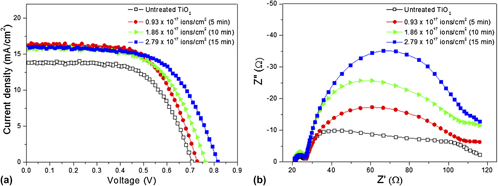Article contents
Oxygen ion-beam irradiation of TiO2 films reduces oxygen vacancies and improves performance of dye-sensitized solar cells
Published online by Cambridge University Press: 01 April 2011
Abstract

Oxygen vacancy-related surface defects on porous TiO2 films were reduced by oxygen ion-beam treatment, and the effect of such defects on the performance of dye-sensitized solar cells was examined. An oxygen ion-beam treatment of a TiO2 film caused a significant decrease in particle agglomeration and an increase in surface area of the resulting TiO2 film. In addition, the increased hydrophilicity of the TiO2 film by the ion beam treatment led to an increase in dye adsorption. The oxygen ion beam treatment at 500 and 1000 eV caused a significant decrease in oxygen vacancies and increase in the open-circuit voltage (Voc). Oxygen ion beam–treated TiO2 film electrodes showed the maximum solar-to-electricity conversion efficiency (η%) of 8.04% compared to the 6.15% obtained from an untreated TiO2 electrode.
Keywords
- Type
- Articles
- Information
- Copyright
- Copyright © Materials Research Society 2011
References
REFERENCES
- 6
- Cited by




